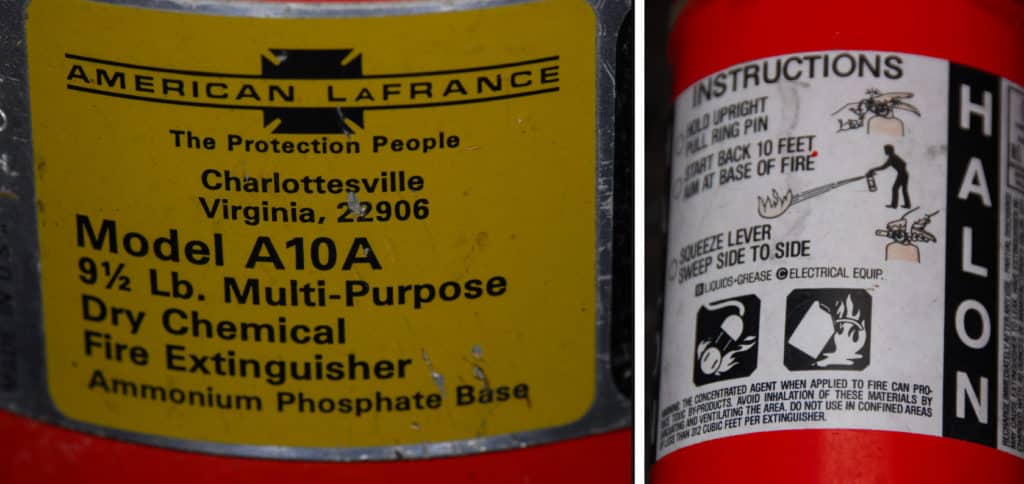
When I recently asked a boatbuilder what type of portable fire extinguisher he installed aboard his boats, the response took me aback. “Does it really matter?” he asked. “Aren’t they all pretty much the same?” Given the alphabet soup by which fires and extinguishers are defined and designated (see “U.S. Fire Classifications”), his answer could be forgiven. However, there are significant differences between such designations.
While fire classifications might be familiar to some, the ratings of fire extinguishers — for instance, 1A and 10B:C — are often enigmatic. For Class A fires, a 1 represents the equivalent of 1.25 gallons of water; 2 the equivalent of 2.5 gallons of water; 3 the equivalent of 3.75 gallons of water; and so on. For Class B and C fires, the number represents the square footage of the area the extinguisher would cover. The suffix in Roman numerals that is used with marine fire extinguishers, such as in B-I and B-II, represents the relative extinguisher capacity (the larger the number, the greater the content). Sizes I and II are the most common extinguishers for recreational craft, while size III is found aboard larger and commercial vessels.
The most common and inexpensive portable fire extinguishers rely on dry chemical agents, including sodium or potassium bicarbonate. Ammonium polyphosphate, the familiar white powder used in Class B:C extinguishers, can have a detrimental effect on mechanical and electrical equipment, particularly if ingested by a running engine or if used on or near sensitive electronics. Monoammonium phosphate, often used in extinguishers with an otherwise desirable ABC rating, is a pale yellow color and is quite corrosive, particularly if exposed to water or even high humidity. Furthermore, the manner in which this agent works (the powdered agent melts to smother the flames) makes cleanup especially difficult.
On the other hand, gaseous fire extinguishers — like the permanent units installed in some engine compartments — rely on a clean agent, one that leaves no residue and will not harm engines, machinery, or electrical and electronic equipment when discharged nearby or even directly onto those components. For portable extinguishers, gaseous units are especially effective on small electrical fires of the type that might occur behind consoles, or in electrical panels and engine compartments. They are an adjunct to, rather than a substitute for, a dry-chemical extinguisher, as they are not effective on Class A and B fires unless flooding an enclosed compartment.
Portable clean-agent extinguishers are available in a variety of agents and sizes, including FM-200, FE-36, Halotron and CO2, in everything from 1.5 pounds (this is very small, designed for light aircraft and automobiles) to 20 pounds. Ideally, at least one clean-agent extinguisher should be installed in a central location. While these extinguishers are more expensive than their dry-chemical counterparts, the damage they can help prevent will more than pay for the additional cost if discharged.
The U.S. Coast Guard requirements for fire extinguishers are, in my opinion, woefully inadequate and should be considered strictly an absolute minimum. A 65-foot vessel is compliant with just one portable B-II and one fixed fire extinguisher (again, I don’t recommend following this guideline). My preference is for a portable ABC unit to be installed in every cabin, along with one clean-agent extinguisher mounted amidships, typically close to the engine and electrical panel. And no fire extinguisher should be more than three steps away.
Review your vessel’s firefighting capability. Augmenting it is often relatively inexpensive and is money well spent.
U.S. Fire Classifications
The following list details how fires are classified in the United States. This list differs slightly in Europe, Australia and other locales.
• Class A: Wood, paper, cloth, trash and other ordinary materials.
• Class B: Gasoline, diesel fuel, oil, paint and other flammable liquids.
• Class C: Live electrical equipment. (Once the electricity is removed, these fires typically become Class A; ideally, electricity should be shut off before fighting the fire.)
• Class D: Combustible metals (for example, magnesium, titanium and potassium).
• Class K: Cooking fires, fats and oils.
Steve D’Antonio offers services for boat owners and buyers through Steve D’Antonio Marine Consulting (stevedmarineconsulting.com).








